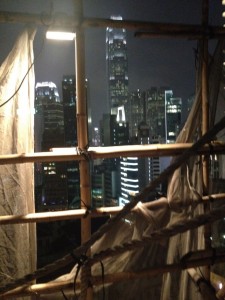I recently provided some free advice on how to approach designing a website for a University Division. It might be worth every penny paid for it.
—
 First off, let me be clear: asking a graphic designer to design your website is akin to asking an Architect to design your landscape. Certainly there are graphic designers who have more experience, but I find this more rare than you would think. A website is not a thing or a place. It is information in motion: from production to delivery. To design a good website, you need to understand your content first, which involves designing and developing a true content strategy. This is more difficult than you think. You need to understand your audience, not just in the simplistic terms of ‘prospective students’. You also need to account for the fact that you won’t get it right at first and that your site must always be evolving. This is what many graphic artists fail to appreciate and respond to, in part because they are probably more used to producing objects. Again, a website is not an object.
First off, let me be clear: asking a graphic designer to design your website is akin to asking an Architect to design your landscape. Certainly there are graphic designers who have more experience, but I find this more rare than you would think. A website is not a thing or a place. It is information in motion: from production to delivery. To design a good website, you need to understand your content first, which involves designing and developing a true content strategy. This is more difficult than you think. You need to understand your audience, not just in the simplistic terms of ‘prospective students’. You also need to account for the fact that you won’t get it right at first and that your site must always be evolving. This is what many graphic artists fail to appreciate and respond to, in part because they are probably more used to producing objects. Again, a website is not an object.
Here are a few more random thoughts.
Your website needs to be built upon a content management system (like WordPress, which I recommend). This will help to streamline how it is built and and how content continues to change. It will also force your designers (hopefully) to recognise the dynamic parts of the site.
It must also be mobile friendly, which I recommend being accomplished with a responsive design. Have a look at the Faculty Website and resize your browser to see how the design changes. Depending on the design itself and other factors you determine by your content strategy, you will have at least 5 relatively different designs (based on the ‘breakpoints’). You need to be thinking about all of these layouts at the same time as you design, and it isn’t easy. It is common to not fully achieve this, but based upon your market, you make certain tradeoffs in the initial implementation. Costs will help to determine this.
Make sure your designers follow an agile development model, which is an iterative approach that will force them to adapt the design as new requirements are determined. This will provide you better feedback and enable you to better manage the project. All good web developers follow this model, at least in part. By the way, the waterfall method, which is to design everything and then build it, has been the standard since the 70s. It was introduced by Winston Royce as a flawed model, but given mankind’s ability or inability to appreciate irony, it has become the way many things are designed and built. Wireframes are almost entirely useless. Decisions will be made which will completely negate your wireframes. For example, when working on your mobile versions, your design sense will be challenged by physical constraints which are absolutely essential to a good product (ie. buttons are two small to touch).
Finally, it is unfortunate that I am no longer working at the University. I had plans to get that whole Faculty in shape in terms of its information. The Division blog, which I was beginning to work on has stalled. I believe that model is the kind of one you need to follow because it places content first and aims to create a low-point of entry for new content. This is so important, as it constructs a network of information, not a website. If you try to build this kind of system, your content becomes immediately shareable (via the social networks like Facebook, Twitter etc.). In my opinion, this will do more for your Division than a visually stunning site. My hope was always that people like you would begin to promote your own work, which would continuously add new and interesting information to the Division. Regarding curation, which becomes the dominate design framework, it needs to be an evolving process.
As for how your Division site will interact with the Faculty Website, my plan was always to thin out the Faculty site and make it mostly an aggregator of the content being produced within the Departments and Divisions. Although I called these other sites ‘blogs’, it is not nor was ever meant to be a derogatory term. I considered them far more important, but I was playing a little slight of hand, to wrestle away the centrally controlled system that was constructed and which simply is not sustainable. Do this project, by all means, but don’t get hung up on the branding (domain name) and visual separation from the Faculty. That is a non-starter and means far less than you think. The only thing that matters on the internet is how people find your information, and once they find it, how they understand it. A good design is one that makes that clear. Unlike a poster, it is not the thing that draws you in. The experience (UX) is what matters because it allows people to continue to use your site and to find more information. I think it is good that you want a simple site. The overall design should aspire towards minimalism, since it is the content and the graphics/images used in the content that will really be the thing that impacts the people who visit your site. Let your work sell itself.
So, I’m sorry that even in my attempt to give you some brief ideas, I go on and on. These ideas are dear to me and I feel very strongly about them, because I understand information. I have a history of presenting these points of view and finding them almost too much for people. I understand only too well that I am advocating for a complete redefinition of the classic website. All I can say is that these ideas are not original – this is the dominant discourse in this field. And it is how you should build your Divisions online information. There is no website. This is no real place to visit. It is something far more ethereal and yet far more powerful and useful.
Let me know if you are interested in hearing more. I also have some books which might help explain my arguments better. One in particular, Designing Disorder, is by the former design director of the NYTimes. It is a very small and straightforward book. And beautiful.
If we can work on redefining some terms, I am confident that I can give you some real ways to discuss this work with your designers that will produce a system – a network of information – that will accomplish what you need it to do. And it will still look great.

